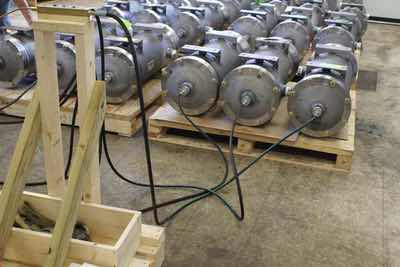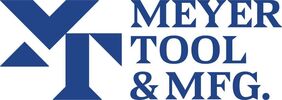Call: 708-425-9080
ASME Code Section VIII Pressure Tests
 Pneumatic pressure testing multiple ASME Code Vessels
Pneumatic pressure testing multiple ASME Code Vessels
All ASME Code Stamped Section VIII pressure vessels must undergo a pressure test. Custom cryogenic pressure vessels with Code Stamps are no different. The requirements for this pressure testing are contained within paragraphs “UG-99 Hydrostatic Pressure Test”, “UG-100 Pneumatic Test”, and “UG-101 Proof Tests to Establish Maximum Allowable Working Pressure” of Section VII of the ASME Code. Anyone even passingly familiar with the Code knows that even the most seemingly simplest of subjects, like Pressure Tests, can lead into a myriad of clarifications and exceptions. For this reason we will limit our discussion to cryogenic pressure vessels built to Division 1 and “Part UHA Requirements for Pressure Vessels Constructed of High Alloy Steel”. Further we will assume that maximum allowable working pressure (MAWP) is determinable by calculation and that UG-101 does not apply.
Pneumatic Testing Conditions
Per the requirements of UG-99 and UG-100 a hydrostatic test (along with a visual inspection during test) is the default test that must be satisfactorily performed as one of the conditions for U stamping the pressure vessel. A pneumatic test may be performed if certain conditions are met. UG-100(a) lists these conditions for pressure vessels:
- that are so designed and/or supported that they cannot safely be filled with water.
- not readily dried, that are used in services where traces of the testing liquid cannot be tolerated and the parts of which have, where possible, been previously tested by hydrostatic pressure to the pressure required in UG-99.
Why The Pressure Test is Performed
Not discussed in UG-99 or UG-100 are the reasons the pressure test is performed. The most obviously of reasons is that the pressure test serves as a proof of design and workmanship verification. Two trusted sources state these reasons for performing the pressure test, summarizing:
- The pressure test uncovers gross errors, due to design or workmanship, including leaks at welded, brazed or flanged connections.
- The application of the test pressure results in a stress relief of the vessel, where local areas of high stress, either due to design or fabrication issues, undergo local yielding at the test pressure, resulting in a better stress pattern after release of the pressure.
Hydrostatic Test
The hydrostatic test utilizes a liquid to fill and pressurize the vessel. Water is most the most commonly used liquid. The hydrostatic pressure is raised inside the vessel until the pressure reaches at least the minimum hydrostatic test pressure which is:
Minimum Hydrostatic Test Pressure = 1.3 X MAWP x LSR
Where LSR is the smallest ratio of the allowable stress at test temperature to the allowable stress at design temperatures of materials used in the vessel construction. (Bolting is excluded except when the calculated test pressure will exceed 90% of the bolt material minimum yield strength at the test temperature.)
For the hydrostatic test the Code recommends the temperature of the vessel and its contents are the same and between a range of 30°F above the minimum design metal temperature (MDMT) and 120°F. After the pressure reaches the test pressure, the pressure is reduced until it reaches a value equal to the test pressure divided by 1.3. A visual examination or gas leak test is used to check for cracks or leaks in all connections and welded joints.
Minimum Hydrostatic Test Pressure = 1.3 X MAWP x LSR
Where LSR is the smallest ratio of the allowable stress at test temperature to the allowable stress at design temperatures of materials used in the vessel construction. (Bolting is excluded except when the calculated test pressure will exceed 90% of the bolt material minimum yield strength at the test temperature.)
For the hydrostatic test the Code recommends the temperature of the vessel and its contents are the same and between a range of 30°F above the minimum design metal temperature (MDMT) and 120°F. After the pressure reaches the test pressure, the pressure is reduced until it reaches a value equal to the test pressure divided by 1.3. A visual examination or gas leak test is used to check for cracks or leaks in all connections and welded joints.
Pneumatic Test
The pneumatic test, on the other hand, utilizes gases, commonly nitrogen gas is specified for custom cryogenic pressure vessels, to perform a similar pressure test. The vessel must meet one or more of the stated conditions to allow the use of the pneumatic test rather than the hydrostatic test. There are valid safety concerns regarding pneumatic testing, as it is intrinsically less safe than hydrostatic testing.
All vessels that undergo a pneumatic test are first examined under the requirements of UW-50, which requires that all openings, welds, and attachments be examined before testing. For cryogenic vessels of the type under discussion this would require liquid dye penetrant testing per UW-50.
The minimum required test pressure for a pneumatic test is
Minimum Pneumatic Test Pressure = 1.1 X MAWP x LSR
Where again LSR is the smallest ratio of the allowable stress at test temperature to the allowable stress at design temperatures of materials used in the vessel construction. (Bolting is excluded except when the calculated test pressure will exceed 90% of the bolt material minimum yield strength at the test temperature.)
For the pneumatic test the Code requires the temperature of the pressure vessel and its contents are the same and between a range of 30°F above the minimum design metal temperature (MDMT) and 120°F. After the pressure reaches the test pressure, the pressure is reduced until it reaches a value equal to the test pressure divided by 1.1. Again a visual examination or gas leak test is used to check for cracks or leaks in all connections and welded joints.
All vessels that undergo a pneumatic test are first examined under the requirements of UW-50, which requires that all openings, welds, and attachments be examined before testing. For cryogenic vessels of the type under discussion this would require liquid dye penetrant testing per UW-50.
The minimum required test pressure for a pneumatic test is
Minimum Pneumatic Test Pressure = 1.1 X MAWP x LSR
Where again LSR is the smallest ratio of the allowable stress at test temperature to the allowable stress at design temperatures of materials used in the vessel construction. (Bolting is excluded except when the calculated test pressure will exceed 90% of the bolt material minimum yield strength at the test temperature.)
For the pneumatic test the Code requires the temperature of the pressure vessel and its contents are the same and between a range of 30°F above the minimum design metal temperature (MDMT) and 120°F. After the pressure reaches the test pressure, the pressure is reduced until it reaches a value equal to the test pressure divided by 1.1. Again a visual examination or gas leak test is used to check for cracks or leaks in all connections and welded joints.
After The Pressure Test
After these tests are performed, the vessels are finally stamped to display that they meet the ASME Code and Meyer Tool standards, ensuring the safety of our customers and their projects. Understanding and applying the proper ASME Code rules are key to the successful design and fabrication of your Custom ASME Code Stamped Cryogenic Pressure Vessel. This understanding and application is just one way Meyer Tool Reduces Project Risk and help you achieve the lowest cost of ownership.
References:
References:
- Farr, J.R. & Jawad, M.H., “Guidebook for Design of ASME Section VIII Pressure Vessels”, 2010 ASME, New York, NY.
- Pastor, T.P., “Companion Guide to the ASME Boiler and Pressure Vessel Code, Volume 2, Fourth Edition, Chapter 21 Section VIII- Division 1: Rules for Construction of Pressure Vessels”, 2010 ASME, New York, NY.



